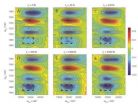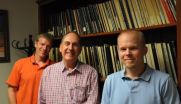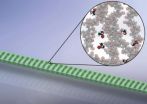(Press-News.org) Ann Arbor, Mich. — Taking part in an educational sleep program resulted in a 30-minute average increase in sleep duration at a one-month follow-up for preschoolers, according to a new study from the University of Michigan.
In the study, published in the journal SLEEP, families in two Head Start programs participated in the Sweet Dreamzzz Early Childhood Sleep Education Program™. The Detroit-area nonprofit organization, Sweet Dreamzzz, Inc. developed the program and offers it for free when funding allows. Head Start programs aim to give preschool opportunities to low-income families, in part to improve readiness for elementary school.
Researchers found that among 152 preschool children and their families, the sleep education program produced a 30-minute increase in sleep duration among the kids, says lead author Katherine (Wilson) DeRue, M.D., M.S., who conducted the study while a postgraduate fellow at the University of Michigan Sleep Disorders Center and Departments of Neurology and Pediatrics.
"We know that an increase in sleep duration of that magnitude is associated with better function for kids during the day" says DeRue, who is now a pediatrician and sleep physician at IHA Pulmonary, Critical Care and Sleep Consultants in Ann Arbor, Mich.
"Parents often underestimate how much sleep their kids require, so an educational program like this, directed at parents when they have more control over their kids' sleep schedules, can have great impact."
The study also found that parents' awareness and knowledge of good sleep behaviors also improved after program participation, but this effect was not sustained when parents were retested one month later.
The educational program included a one-time, 45-minute sleep education program for parents, and two weeks of classroom sleep education for the preschoolers. Parents were asked to keep diaries for assessment of their children's sleep habits.
"So we found that a two-week program of daily exposure to sleep education in the preschool classroom, along with an initial presentation for parents, can be an effective strategy," says Ronald D. Chervin, M.D., M.S., the study's senior author, director of the U-M Sleep Disorders Center, and a volunteer on Sweet Dreamzzz's Advisory Board.
"But repeated exposure or reminders about the sleep information may be necessary to maintain the effects for kids and especially parents over time."
This is believed to be the first study to examine the effect of a sleep education program on the sleep of preschool age children.
The Head Start programs were located in greater Lansing, Mich. and Detroit, Mich.
The lessons taught in school seemed to stick with the children. Among the lessons were recognizing 8 p.m. as the desirable bedtime; learning that an apple is a better snack before bedtime than a candy bar; and identifying reading rather than watching TV as a relaxing activity before bedtime.
"We are pleased to see that the University of Michigan researchers have been able to measure the impact of our sleep program. We know a proper sleep environment, regular bedtime routine, and the right amount of sleep hours each night can impact the future of our children," says Nancy Maxwell, executive director of the non-profit Sweet Dreamzzz, Inc.
Sweet Dreamzzz provides educational programs on sleep, along with free sleep essentials– such as sleeping bags, toothbrushes, and books about sleep -- to schoolchildren in low-income areas. Sweet Dreamzzz's main aims are to encourage better sleep – and thereby better health and learning -- at the earliest ages.
Most evidence indicates that children commonly obtain insufficient sleep, says DeRue, and this study provides a critical demonstration that minimal, relatively inexpensive interventions can make a difference.
"Family sleep education during early childhood years, when the sleep habits are being established, could prove to be a cost-effective but impactful strategy to improve children's overall health," says DeRue.
"Nutrition and exercise are commonly the focus of educational efforts to improve children's health," adds Chervin. "Good sleep – in quality and quantity -- is no less vital to our kids' future, yet it's rarely if ever discussed. Our new findings suggest that a small amount of effort to promote better sleep could have substantial benefit now, and conceivably for years to come as these youngsters grow older."
INFORMATION:
Additional authors: Julie C. Lumeng, M.D. and Allison L. Miller, Ph.D. of the University of Michigan; Karen Bonuck, Ph.D., of Albert Einstein College of Medicine.
Journal reference: http://dx.doi.org/10.5665/sleep.3774
Funding: This study was funded by the Michigan Center for Integrative Approaches to Health Disparities and the National Institute on Minority Health and Health Disparities (P60 MD002249); a Humanitarian Award from the American Sleep Medicine Foundation to Sweet Dreamzzz, Inc; a Physician Scientist Training Award to K.E.W. from the American Sleep Medicine Foundation; and by a training grant from the National Institute for Neurological Disorders and Stroke (5T32 NS007222).
About the U-M Sleep Disorders Center: The University of Michigan Sleep Disorders Center diagnoses and treats patients who have problems with their sleep or level of alertness. The Center is among the largest academic facilities of its kind in the country and includes several parts: a number of general and more specialized Sleep Disorders Clinics; the Michael S. Aldrich Sleep Disorders Laboratory; the University of Michigan Sleep Disorders Laboratory – South State Street; active training programs; and productive research projects.
http://www.uofmhealth.org/medical-services/sleepmedicine
About U-M C.S. Mott Children's Hospital: C.S. Mott moved to a new home in December 2011. The $754 million hospital features a 1.1 million square foot, 348-bed facility that is home to C.S. Mott Children's Hospital, the Von Voigtlander Women's Hospital, and adult and pediatric blood and marrow transplant programs. The new hospital features a 12-story inpatient tower and nine-story clinic tower, a dedicated pediatric emergency department, an on-site Ronald McDonald House, and private rooms. The hospital also offers a new and larger home for specialty services not offered anywhere else in Michigan for newborns, children and pregnant women.
To learn more about C.S. Mott Children's Hospital, visit http://www.mottchildren.org
About Sweet Dreamzzz, Inc.: Sweet Dreamzzz, Inc. was founded in 2001 and is headquartered in Farmington Hills, MI. The organization is committed to improving children's health, well-being, and academic performance by providing sleep education and bedtime essentials to economically disadvantaged students and their families. Over 42,000 children ranging from preschool to 8th grade and their families have been given Sweet Dreamzzz sleep programs.
To learn more about Sweet Dreamzzz, visit http://www.sweetdreamzzz.org
Sleep education program spurs preschoolers to snooze 30 minutes longer at night
Early interventions among Head Start preschool families improve sleep behaviors for kids, parents, according to new U-M study
2014-06-17
ELSE PRESS RELEASES FROM THIS DATE:
Dynamic spectroscopy duo
2014-06-17
From allowing our eyes to see, to enabling green plants to harvest energy from the sun, photochemical reactions – reactions triggered by light – are both ubiquitous and critical to nature. Photochemical reactions also play essential roles in high technology, from the creation of new nanomaterials to the development of more efficient solar energy systems. Using photochemical reactions to our best advantage requires a deep understanding of the interplay between the electrons and atomic nuclei within a molecular system after that system has been excited by light.
A major ...
Why species matter
2014-06-17
UC Santa Barbara doctoral candidate Caitlin Fong travels to French Polynesia often but not for vacation. She goes there to study a coral reef ecosystem influenced by human impacts such as overfishing and nutrient pollution.
Her work focuses not only on biological changes but also methods scientists use to determine within-group group responses to ecological processes. The findings are published in ESA Ecology, a journal of the Ecological Society of America.
Fong and Peggy Fong, a professor in UCLA's Department of Ecology and Evolutionary Biology, conducted a study assessing ...
Not so fast -- our fishy friends can also feel pain
2014-06-17
Do you still believe that fish are dumb and cannot feel pain? That we do not have to worry much about how they are cared for or caught? Think again, says Culum Brown of Macquarie University in Australia, in a review article in Springer's journal Animal Cognition. The research notes that fish cognition and their sensory perception are generally on par with that of other animals. Brown therefore argues that more consideration should be given to fish welfare and anti-cruelty issues.
The Australian researcher says that most people rarely think about fish other than as food, ...
$2.4 million NIH center grant to develop a cleaner, healthier environment in Detroit
2014-06-17
DETROIT — With over $2.4 million in new federal funding, Wayne State University researchers, regional collaborators at Henry Ford Health System, the University of Michigan and Michigan State University, and community partners will study how exposures to stressors that are prevalent in the urban industrialized environment — both chemical and non-chemical — impact human health in Detroit and beyond.
The grant, Center for Urban Responses to Environmental Stressors (CURES), is one of approximately 20 select P30 Core Centers funded by the National Institute of Environmental ...
Do 'walkable' neighborhoods reduce obesity, diabetes?
2014-06-17
June 17, 2014 (San Francisco) – People who live in neighborhoods that are conducive to walking experienced a substantially lower rate of obesity, overweight and diabetes than those who lived in more auto-dependent neighborhoods, according to a pair of studies presented at the American Diabetes Association's 74th Scientific Sessions®.
Researchers in Canada compared adults living in the most and least "walkable" metropolitan areas in southern Ontario and found a lower risk of developing diabetes over a 10-year period for those who lived in neighborhoods with less sprawl, ...
Heparin derivative suppresses neuroblastoma tumor growth
2014-06-17
DURHAM, N.C. -- Researchers at Duke Medicine have identified a new strategy for treating neuroblastoma using a modified version of heparin, a century-old injectable drug that thins the blood to prevent clots from forming.
The study, conducted in mice and published June 17, 2014, in the Journal of Clinical Investigation, found that when heparin is altered to remove its blood-thinning properties, it can suppress and shrink neuroblastoma tumors without causing severe bleeding.
"Our research translates mechanistic insights about heparin into a potential new therapy for ...
Urban Water Management Workshop stresses more collaboration and innovation
2014-06-17
RIVERSIDE, Calif. — Where sustainability of water management is concerned, we must pay more attention to long-term solutions. Efficient water management and policy ought to be promoted at the local level. And a "portfolio approach" to water management is encouraged, one that includes information campaigns, different types of pricing, supply and reuse options, and technology-based rebate programs.
These are some of the key messages that emerged from the first Urban Water Management Workshop that took place earlier this month at the University of California, Riverside.
Sponsored ...
Swell new sensors
2014-06-17
WASHINGTON D.C., June 17, 2014 – Using microscopic polymer light resonators that expand in the presence of specific gases, researchers at MIT's Quantum Photonics Laboratory have developed new optical sensors with predicted detection levels in the parts-per-billion range. Optical sensors are ideal for detecting trace gas concentrations due to their high signal-to-noise ratio, compact, lightweight nature, and immunity to electromagnetic interference.
Although other optical gas sensors had been developed before, the MIT team conceived an extremely sensitive, compact way ...
Ultra-thin wires for quantum computing
2014-06-17
WASHINGTON D.C., June 17, 2014 - Take a fine strand of silica fiber, attach it at each end to a slow-turning motor, gently torture it over an unflickering flame until it just about reaches its melting point and then pull it apart. The middle will thin out like a piece of taffy until it is less than half a micron across -- about 200 times thinner than a human hair.
That, according to researchers at the Joint Quantum Institute at the University of Maryland, is how you fabricate ultrahigh transmission optical nanofibers, a potential component for future quantum information ...
Study reveals conditions linked to deadly bird flu and maps areas at risks
2014-06-17
BEIJING, CHINA (17 June 2014)—A dangerous strain of avian influenza, H7N9, that's causing severe illness and deaths in China may be inhabiting a small fraction of its potential range and appears at risk of spreading to other suitable areas of India, Bangladesh, Vietnam, Indonesia and the Philippines, according to a new study published today in the journal Nature Communications.
Researchers from the Université Libre de Bruxelles (ULB), the International Livestock Research Institute (ILRI), Oxford University, and the Chinese Center of Disease Control and Prevention analyzed ...
LAST 30 PRESS RELEASES:
Study showcases resilience and rapid growth of “living rocks”
Naval Research Lab diver earns Office of Naval Research 2025 Sailor of the Year
New Mayo-led study establishes practical definition for rapidly progressive dementia
Fossil fuel industry’s “climate false solutions” reinforce its power and aggravate environmental injustice
Researchers reveal bias in a widely used measure of algorithm performance
Alcohol causes cancer. A study from IOCB Prague confirms damage to DNA and shows how cells defend against it
Hidden viruses in wastewater treatment may shape public health risks, study finds
Unlock the power of nature: how biomass can transform climate mitigation
Biochar reshapes hidden soil microbes that capture carbon dioxide in farmland
Reducing saturated fat intake shows mortality benefit, but only in high-risk individuals
Manta rays create mobile ecosystems, study finds
Study: Mixed results in using lipoic acid to treat progressive multiple sclerosis
Norbert Holtkamp appointed director of Fermi National Accelerator Laboratory
New agentic AI platform accelerates advanced optics design
Biologists discover neurons use physical signals — not electricity — to stabilize communication
Researchers discover that a hormone can access the brain by hitchhiking
University of Oklahoma researcher awarded funding to pursue AI-powered material design
Exploring how the visual system recovers following injury
Support for parents with infants at pediatric check-ups leads to better reading and math skills in elementary school
Kids’ behavioral health is a growing share of family health costs
Day & night: Cancer disrupts the brain’s natural rhythm
COVID-19 vaccination significantly reduces risk to pregnant women and baby
The role of vaccination in maternal and perinatal outcomes associated with COVID-19 in pregnancy
Mayo Clinic smartwatch system helps parents shorten and defuse children's severe tantrums early
Behavioral health spending spikes to 40% of all children’s health expenditures, nearly doubling in a decade
Digital cognitive behavioral treatment for generalized anxiety disorder
Expenditures for pediatric behavioral health care over time and estimated family financial burden
Air conditioning in nursing homes and mortality during extreme heat
The Alps to lose a record number of glaciers in the next decade
What makes a good proton conductor?
[Press-News.org] Sleep education program spurs preschoolers to snooze 30 minutes longer at nightEarly interventions among Head Start preschool families improve sleep behaviors for kids, parents, according to new U-M study





